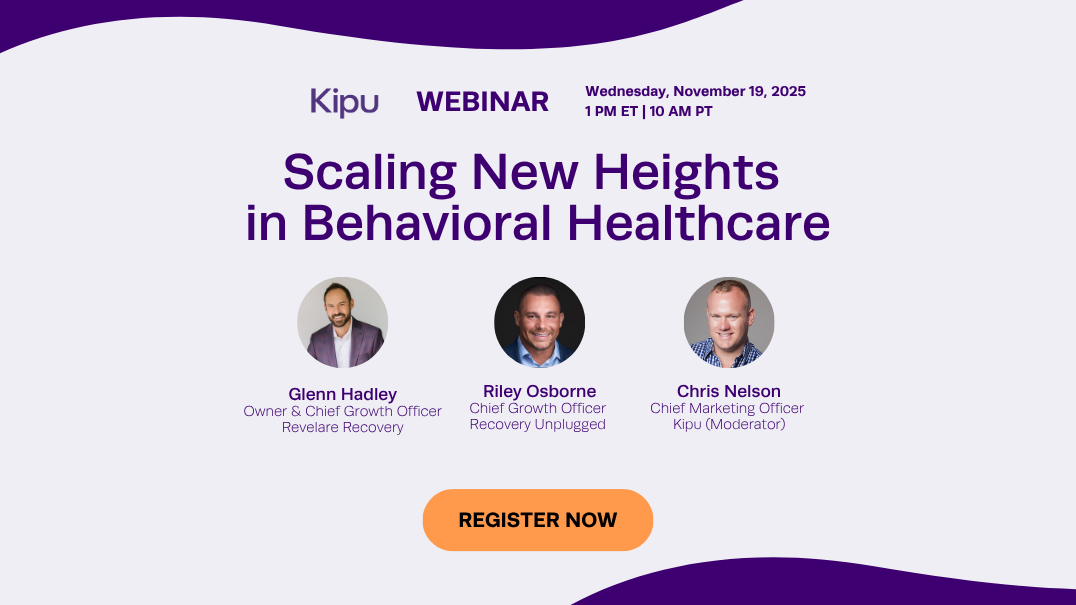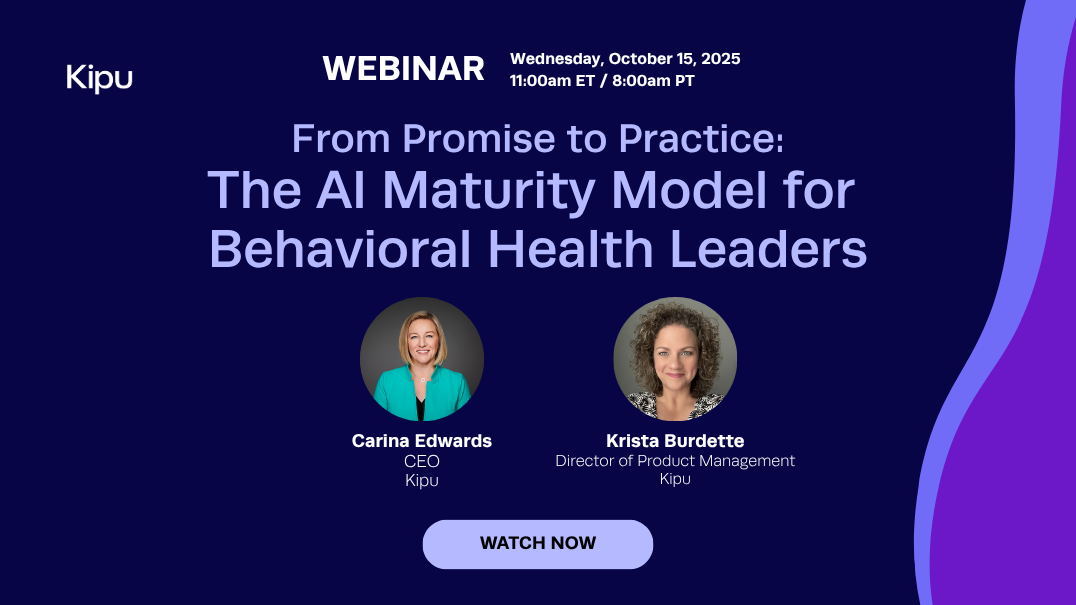From Promise to Practice: Building AI Maturity through Trust and Impact

At Kipu, we’ve seen firsthand that the difference between an AI experiment and an AI advantage comes down to maturity. In our recent webinar, From Promise to Practice: The AI Maturity Model for Behavioral Health Leaders, Carina Edwards and Krista Burdette unpacked this idea in depth, showing that AI maturity is about more than technology adoption. It’s about how an organization aligns its people, processes, and purpose to unlock the real benefits of innovation. Maturity means building trust, clarity, and culture so that technology strengthens care delivery rather than complicating it. Here are five steps from the webinar that can help you advance along the AI maturity curve starting now.
Step One: Start at Base Camp with Purpose, Not Product
As Carina Edwards, our CEO, mentioned, “Technology won’t fix bad process.” The first step toward AI maturity should be a purpose statement instead of a purchase order. What are you trying to solve? Reducing documentation time? Strengthening compliance? Protecting reimbursement? Improving the clinician experience? Until you can clearly articulate that why, AI risks adding complexity instead of clarity.
At Kipu, we think of the AI journey like a climb. Base camp is where you orient yourself, defining what’s possible, setting benchmarks, and getting everyone aligned on what success will look like. Most behavioral health organizations are still between base camp and the early climb: building digital foundations, piloting low-risk tools, and learning how to scale responsibly. Getting to the next stage is all about building trust.
Step Two: Build Trust Through Small, Visible Wins
AI maturity doesn’t happen in a single rollout. It happens through steady, trust-building wins. One of the most effective early steps we’ve seen is introducing AI where the risk is low and the value is immediate, such as using tools that summarize charts or assist with documentation. These aren’t replacing clinicians; they’re freeing them.
When Banyan Treatment Centers began using Kipu Intelligence’s Note Assistant, their clinicians reduced documentation time by 30–40 percent. Assessments that once took an hour now take about twenty minutes. Follow-up notes went from fifteen minutes to five. That’s time returned to patient care, staff collaboration, or—let’s be honest—a normal evening at home.
Those early wins create something more powerful than efficiency: trust. Clinicians stop seeing AI as a project and start seeing it as a partner.
Step Three: Keep the Human in the Loop
Behavioral health will always be a human-centered field. The therapeutic alliance—the connection between provider and patient—is the heart of every outcome. That’s why AI in this space must live quietly in the background, not at the bedside. The best use cases reduce the administrative weight so clinicians can focus on empathy, observation, and treatment. When AI prepares a chart summary before a session or flags missing compliance items during documentation, it’s not replacing judgment—it’s strengthening it.
Or as Krista Burdette, Kipu’s VP of Product, puts it: “Tech isn’t the savior. It’s the assistant.” This mindset is what distinguishes mature organizations from reactive ones. At those kinds of organizations, clinicians remain the decision-makers, using technology to enhance therapeutic relationships, not automate them.
Step Four: Govern Ethically, Lead Transparently
Innovation shouldn’t outpace responsibility. Mature organizations build guardrails early to protect patient data, address bias, and ensure transparency.
That’s why Kipu grounds its AI development in ethical frameworks, rigorous compliance (including HITRUST and ISO 42001 certifications), and what we call the “human-in-the-loop” principle. Data is secure. Oversight is intentional. Clinicians stay in control.
Governance alone isn’t enough; culture matters just as much. When leaders actively use AI and openly share how and why they use it, they set the tone for the entire organization. It’s equally important to create channels for staff to learn, exchange best practices, and provide feedback. As I mentioned in the webinar, our team has integrated a quick 5-minute “AI corner” into our weekly meeting, where a member of the teams shares a way they’ve been using AI either at work or in their personal life. One teammate’s use of AI to build out custom maps for personal travel has become SOP now for our events team planning travel for conferences.
Encouraging curiosity over perfection helps things like AI become part of your culture.
Step Five: Focus on Outcomes, Not Hype
When behavioral health leaders talk about AI, the goal isn’t AI itself, it’s outcomes like less burnout, stronger compliance, faster reimbursements, and healthier patients.
AI maturity is about embedding technology so seamlessly that it stops being the headline. It becomes the quiet force behind better care, higher accuracy, and more sustainable organizations. As Krista Burdette noted during the webinar, “When clinicians fall back in love with their work, that’s when AI has done its job.”
The Climb Is Worth It
The journey to AI maturity is all about climbing steadily with purpose to give your team time back, your patients more attention, and your organization the ability to thrive in a rapidly changing field.
If you’re ready to take the next step, Kipu can help you define your base camp and begin your climb.
Missed the webinar?
You can watch the full discussion with Banyan and Kipu leaders here:
Want to see how Kipu can help your organization build resilience, scalability, and compliance into your operations?
Recent Posts
Rely on Kipu to keep you ahead of change.
Subscribe to Kipu for behavioral health news, updates, community celebration, and product announcements.



